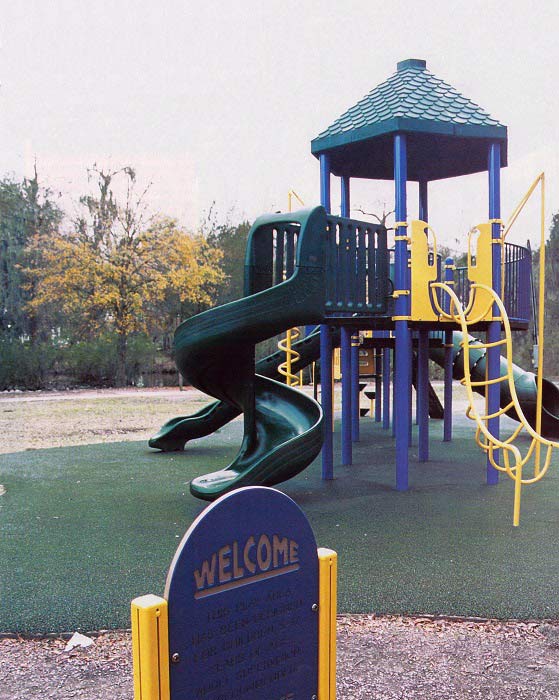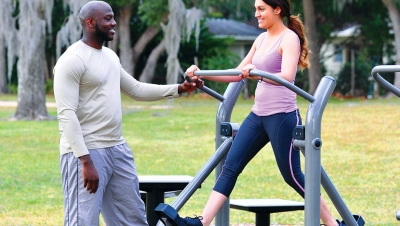The Comforts Of A Great Playground
"Hey Mom, please sit over there, I want to play and can do it myself."
That's our little friend Matthew telling his mother, Sue, that he wants to play with his friends without her by his side. That has to be tough for Sue, because Matthew has, until now, wanted her included in his play. Matthew really wants to be on his own. How should Sue react to his need for independence?
As parents and caregivers, it is difficult at times to allow our children to be out of our presence. We feel compelled to hover over every movement and maintain a certain amount of control of their surroundings. Children, on the other hand, yearn for independence and need opportunities to master their own environment, to involve themselves in the essence of play. They want to be able to explore, pretend and just plain have fun. What Sue needs is a comfortable setting that satisfies her desire to supervise Matthew, but allows him to feel or perceive that he is "out of sight" and in control of his space. As playground professionals, we have a great and often overlooked solution to this dilemma: site amenities.
WHAT ARE SITE AMENITIES?
If we look up amenities in the dictionary, we find that they are defined as desirable or useful features of a place, the pleasantness of a place. In the case of playground environments, amenities are any item or object that improves the quality of the site. It is site amenities, in combination with the play equipment, surfacing and pathways that help create what designers and landscape architects cal I, "a sense of place." This is where people feel comfortable and enjoy their interactions with the surroundings, environment and other people.
We want the playground environments to look appealing, fun and safe to attract people to the site. Site amenities are a vital component in creating a sense of place, but are often viewed as an afterthought or not included as part of the playground environment.
As in the world around us, we see the most successful ecosystems are the ones that have the greatest diversity. Diversity of elements, textures, surfaces and spaces are some of the elements in a sensory-rich environment. By strategically placing these elements, we are establishing the foundation for creating a desirable site. With regard to site amenities, we want to be certain that the elements address some major design issues.
SITE AMENITIES AND SAFETY
First, the site amenities should be laid out to facilitate supervision and safety. By doing that, we are making certain that the placement of all objects maintain, or better yet, facilitate improved safety of the playground environment. The design must take into account the needs of children and adults. Signs are recommended and should be placed at major entry points into the playground. These signs can be as creative and user-friendly as possible, but should contain information such as who the owner/operator of the playground is, what appropriate group the equipment is designed for, contact information in case of accident or damage, and even playground rules. If playground rules are identified, try to be positive and keep the wording simple, like "be safe" and "respect others."
Providing clear site lines helps adults supervise children more easily. That is especially true in a public park setting where there is no active adult facilitator to supervise the children, but rather the responsibility is assumed upon the parent or caregiver in a passive supervisory role. For instance, benches should be placed in close proximity to the play equipment, away from high-use traffic zones, but where major sight lines to and through the playground are achieved. The areas of concern where observation is important include semi-enclosed spaces under platforms, moving play equipment, intersections in the circulation routes and entry/exit points of the playground. The design layout should also account for emergency routes and allow access for emergency vehicles where an opening is at least 8-feet wide.

SITE AMENITIES AND CLIMATIC CONDITIONS
Secondly, site amenities are aesthetically pleasing to the eye and improve the quality of the site. Inclusion of shade is one of the most important amenities that can be designed into a playground site. On hot, humid, sunny days, we can lower the temperatures up to 30 degrees by creation and maximizing shady areas. Shade should be considered for adults/caregivers and the children using the playground. Placing the playground environment near existing trees to provide shade is a great solution; however, if the trees are newly planted, it can take several years before a 3-inch caliper tree has a sufficient canopy to benefit the site. Besides trees, playground companies offer roofs that can be placed over the play equipment platforms. Many of the manufacturers have large, free-standing canopies available which can add to the festive nature of the environment.
Water is being used more and more as a play element. In addition to drinking fountains, "spraygrounds" are gaining popularity and the opportunities to incorporate one should be considered as a viable part of the playground environment. They don't appear to have the issues of sanitation or maintenance and are relatively lower in initial cost than the old-fashioned wading pools. "Spraygrounds" can also generate the play activity from the ground surface, which alleviates safety concerns and falls onto hard surfaces when the area is not in use.

SITE AMENITIES AND USERS
Furnishing amenities designed to the ability of the users is important. The Americans with Disabilities Act (ADA) ensures that public spaces - in our case, playground environments - are accessible to all persons regardless of abilities. Site amenity design and placement should be sensitive to all users. The scale of the amenities and the spaces by which they are placed is also an important design consideration.
SITE AMENITIES ENHANCE PLAY
Finally, site amenities should promote positive play experiences. A playground environment can be so much more than the equipment children use. When we remember our own experiences playing, we may recall the detaiIs of what was present, but invariably, we savor how we felt, the outcomes of our play and that we were in control of what we did. This is the essence of play, our sense of place. When we are able to incorporate amenities such as water, shade, landscaping and other elements to play equipment areas, we can enhance the experience of children in play. The playground environment becomes the vehicle for their essence of play. That is the key, because if we are unable to create a setting that is attractive, safe and fun, then we are missing opportunities to have a positive effect on our children and communities.
"C'mon Matthew, it's time to go."
"Hang on Mom, let me land my space craft and collect my moon rocks first."









Add new comment